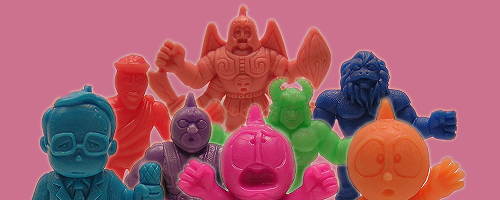 |
 |
|
How does the MUSCLE Color Code work? The first bit of information you must know is that MUSCLE men are the American version of Japanese Kinnikuman. Kinnikuman figures were released in Japan in a series of sets called "Parts." (1) Step one of "solving" the MUSCLE color code is to determine which MUSCLEs belong to which Kinnikuman Parts. All this entails is visiting Naochin's Kinnikuman Parts archive. There you find images of all the Kinnikuman organized by their parts. |
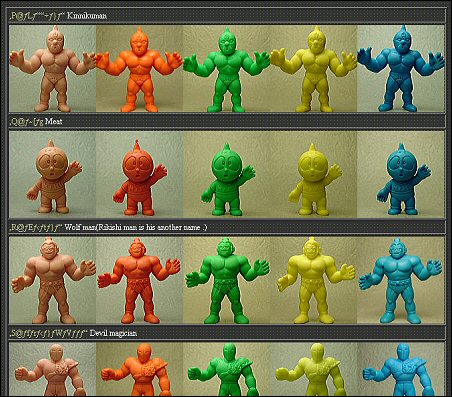 |
|
The original Kinnikuman figures were released in Japan in a number of series referred to as "parts." |
|
(2) Once you determine which MUSCLE sculpts belong to which Kinnikuman Parts, you need to find the "stats" for each MUSCLE sculpt. This entails visiting the MUSCLE Database web site. Determine which colors each sculpt has been recorded as found in by collectors.
|
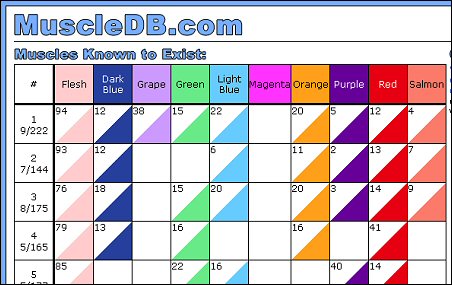 |
|
The MUSCLE Database allows collectors to indentify in which color they've found each sculpt. |
|
(3) Once you (a) know which Kinnikuman Part a MUSCLE sculpt belongs to and (b) have determined which colors it is reported as found in you can (c) compare it to other MUSCLE sculpts that belong to the same Kinnikuman Part. A pattern, or multiple patterns, of MUSCLE color cominations within each Part will emerge.
For example, in the image below, you are looking at the breakdown of all the MUSCLEs that belong to Kinnikuman Part One (done by Universal Ruler Supreme). First you must note that the original Kinnikuman Part One consisted of 20 sculpts. However, for some reason, one of these sculpts was NOT made into a MUSCLE sculpt. Therefore, there are only 19 MUSCLE sculpts in the first Part.
You'll notice that two patterns emerge, which URS organized into Tree One and Tree Two (more on the term "tree" later). The first pattern (tree one) is slightly disrupted by reports of a few sculpts in Magenta and Orange. In the second pattern (tree two) there are NO MUSCLE sculpts reported to be found in Dark Blue. So, despite the few odd reports in the first pattern, the two patterns are strong enough in numbers that we can be fairly confident in "officially" grouping the first Part into two trees.
|
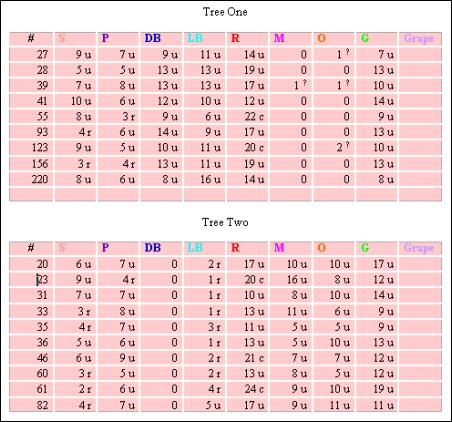 |
|
MUSCLE figures grouped by Kinnikuman Part and MUSCLE Database stats. |
|
(4) Once you have all the MUSCLEs organized by which Kinnikuman Part they belong to and by the colors they are reported as found in via the MUSCLE Database, you can organize their images into the MCIA Kinnikuman Parts!
|
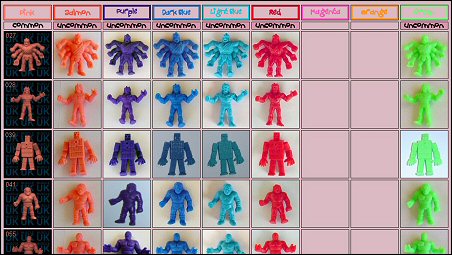 |
| A portion of MCIA Kinnikuman Parts, Part One.
|
|
But why call the patterns trees? The term comes from a discovery made by a MUSCLE collector called Arforbes. MUSCLE figures (and Kinnikuman figures) are made via a process known as injection molding. Arforbes discovered a bunch of Kinnikuman figures still attached to their molding "tree."
After Arforbes made his discovery, I deduced that MUSCLE men must also have been made in these groupings, or trees. Therefore, when one uses the above method to uncover the "MUSCLE color code" what one is really doing is determining which MUSCLEs were molded together on the same trees -- and therefore in the same colors!
|
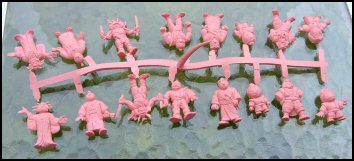 |
| MUSCLE Figures were made in groups I refer to as trees.
|
|
Problems with this method? The problem with this method can be seen above. As noted in the first pattern (tree) of Part One, a few figures have been reported as being found in Magenta and Orange. However, I have NO images of sculpts from this grouping in Magenta and Orange. Furthermore, only a few collectors (1 or 2 at the most) report having found these sculpts in Magenta and Orange. So, I conclude that it is highly likely that these few reports are simply mistakes. However, there remains the possibility that these sculpts DO come in Magenta and Orange. If that's the case, they would no longer fit the current pattern. So, either the pattern would need to be adjusted (to include Orange or Magenta) or a third pattern (tree) might emerge for the Part. |
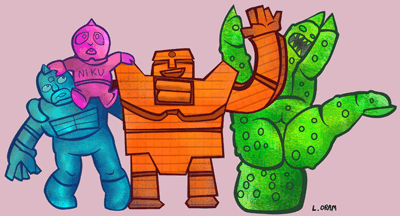 |